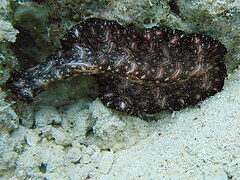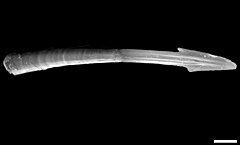User:RichardWeiss/Classes
List of eukaryote classes There are 4 kingdoms within eukaryote cells
Kingdom Protista[edit]
Kingdom Plantae[edit]
Kingdom Fungi[edit]
Kingdom Animalia[edit]






Subkingdom Parazoa[edit]

- Phylum Placozoa
One species Trichoplax adhaerens
- Phylum Porifera (Sponges)
- Class Calcarea
- Class Hexactinellida
- Class Demospongiae
- Class Homoscleromorpha
Subkingdom Eumetazoa[edit]
Eumetazoa is a subkingdom which contains two unranked groups, the Radiata and the Bilateria, which itself contains one unranked group, Mesozoa and four superphyla, Deuterostomia, and the three Protostome superphyla Ecdysozoa, Platyzoa and Lophotrochozoa.
Radiata[edit]
- Phylum Cnidaria
- Class Anthozoa - inc. corals
- Subphylum Medusozoa—jellyfish:[1]
- Subphylum Myxozoa—parasites[2]
- Malacosporea
- Myxosporea
- Phylum Ctenophora
- Class Tentaculata
- Class Nuda
- Class Scleroctenophora[3] †
- Phylum Trilobozoa†
- c Trilobozoa
Bilateria[edit]
- Superphylum Deuterostomia
- Phylum Chordata
- Phylum Hemichordata
- Class Enteropneusta (Acorn worms)
- Class †Graptolithina
- Class Planctosphaeroidea
- Class Pterobranchia
- Phylum Echinodermata
- Phylum Hemichordata
- Phylum Xenacoelomorpha has one family Xenoturbellidae and one genus Xenoturbella
- Phylum Vetulicolia †
- Protostomia
- Superphylum Ecdysozoa
- Phylum Scalidophora (unranked)
- Phylum Kinorhyncha
No class, 2 orders, called mud dragons, very common in mud or sand
- or Cyclorhagida
- or Homalorhagida
- Phylum Loricifera
No class, one order Nanaloricida
- Phylum Priapulida
- Class Priapulimorpha
- Class Halicryptomorpha
- Class Seticoronaria
- Phylum Nematoda
- Phylum Priapulida
25,000 recorded species, estimated to be a million
- Class Chromadorea (disputed)
- Class Enoplea (disputed)
- Class Secernentea
- Phylum Nematomorpha
- Class Gordioidea
- Class Nectonematoida
- Phylum Panarthropoda (unranked)
- Phylum Lobopodia
- Class Dinocaridida †
- Class Xenusia †
- Class Siberion † and relatives
- Class Hadranax †
Onychophora (in some usages) Tardigrada (in some usages)
- Phylum Dinocarida †
- Phylum Xenusia †
- Phylum Onychophora
- Phylum Tardigrada
- Class Eutardigrada
- Class Heterotardigrada
- Class Mesotardigrada
- Phylum Arthropoda
- Superphylum Platyzoa
- Phylum Platyhelminthes (flatworms
- Class Cestoda
- Class Monogenea
- Class Trematoda
- Class Turbellaria
- Phylum Gastrotricha
No classes
- Phylum Rotifera
- Class Bdelloidea
- Class Monogononta
- Class Seisonidea
- Phylum Acanthocephala
- Class Archiacanthocephala
- Class Eoacanthocephala
- Class Palaeacanthocephala
- Phylum Gnathostomulida
No classes
- Phylum Micrognathozoa
Some dispute here with Micrognathozoa as the class and Limnognathia as the order
- Phylum Cycliophora
- c Symbiida
- o Symbiidae
- Superphylum Lophotrochozoa
- Phylum Sipuncula
- Class Phascolosomatidea
- Class Sipunculidea
- Class Anopla
- Class Enopla
- Phylum Phoronida
- Class Phoronid
- Phylum Bryozoa
- Class Gymnolaemata
- Class Phylactolaemata
- Class Stenolaemata
- Phylum Entoprocta
- Phylum Bryozoa
No classes, no orders, families Barentsiidae, Loxokalypodidae, Loxosomatidae, Pedicellinidae
- Phylum Brachiopoda
This is problematic with no infobox info and a confusing box in the taxonomy section, how not to do it
- Phylum Mollusca
- Phylum Annelida
- Class Polychaeta
- Class Clitellata
- Class Machaeridia
- Class Echiura
- Phylum Annelida
Disputed bilaterians[edit]
There is debate as to whether these Mesooa phyla and other phyla are bilaterians.
- Phylum Orthonectida
- Phylum Protostomia (unranked)
- Phylum Proarticulata † Disputed if this is in or out of Bilateria.
Mesozoa
- Phylum Orthonectida
- Phylum Rhombozoa
- Phylum Monoblastozoa
3[edit]
- Phylum Acoelomorpha
- Phylum Chaetognatha mentioned in opening
- ^ Classes in Medusozoa based on "The Taxonomicon – Taxon: Subphylum Medusozoa". Universal Taxonomic Services. Retrieved 2009-01-26.
- ^ Cite error: The named reference
Collins2002PhylogenyOfMedusozoawas invoked but never defined (see the help page). - ^ A vanished history of skeletonization in Cambrian comb jellies
